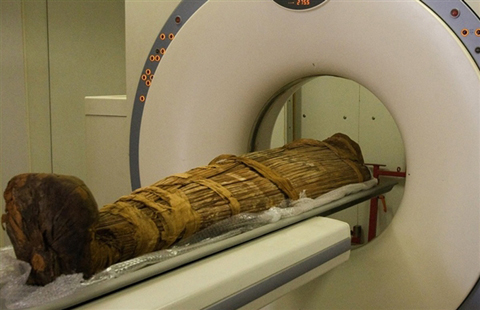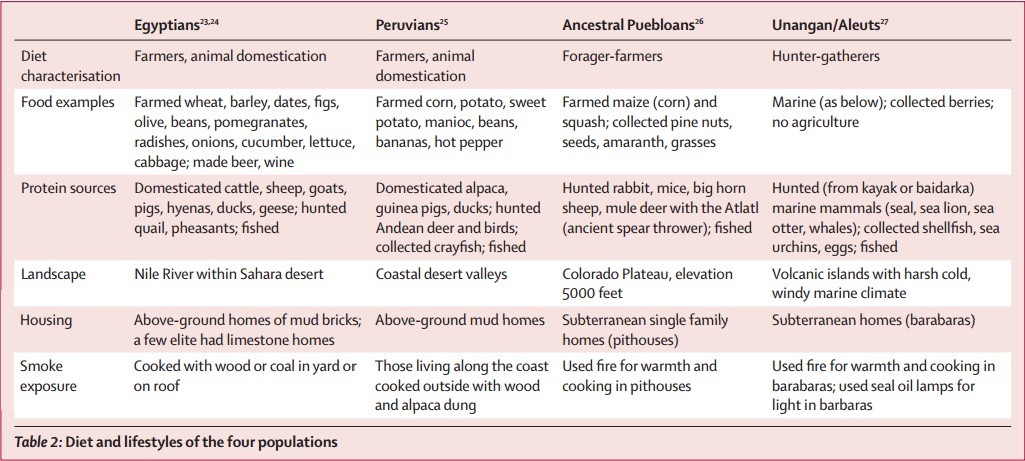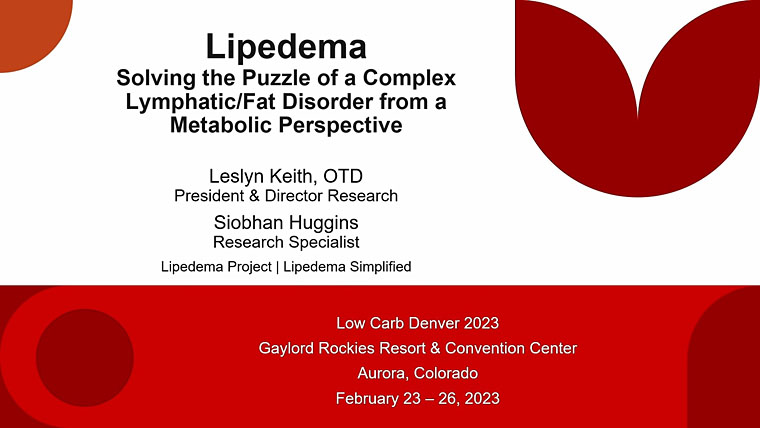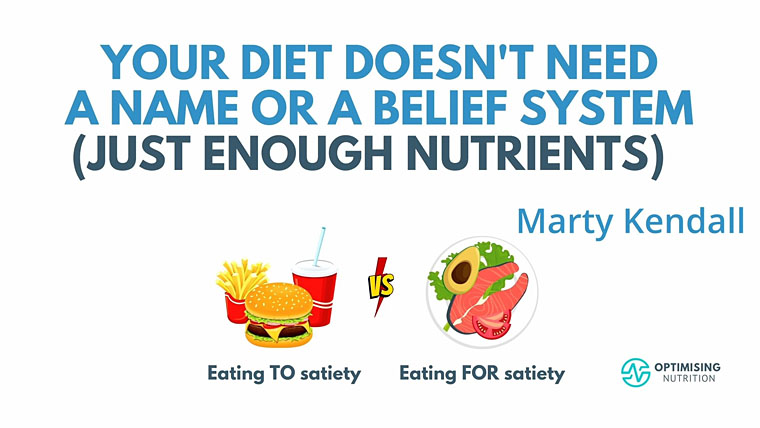Add Clogged Arteries to the list of just some of the chronic diseases found in Ancient mummies. The HORUS study just published in the Lancet and presented at a meeting of the American Academy of Cardiology theorizes that humans are sensitive to the development of atherosclerotic plaque regardless of diet and contemporary lifestyle. Although I find this study fascinating, I do not see a basis for the comments regarding diet.
This study attempted to look at mummies from four diverse ancient populations to see if diet and other factors contributed to the development of calcium deposits in blood vessels.
137 mummies – 76 ancient Egyptians, 51 Peruvians, 5 ancestral Puebloans and 5 Unangans/Aleuts were specifically scanned looking for calcium deposits in major blood vessels. 34% of the mummies were found to contain calcium build up in locations where plaque is typically seen.
Table 2 (below) lists the diet characterization and food examples among other distinguishing features. The more advanced civilizations, including the Egyptians and Peruvians (mummies dating from 3100 BCE-1500 CE) were considered farmers with animal domestication. Ancestral Puebloans (mummies dating from 1500 BCE-1500 CE) were considered foragers and farmers. The final civilization was Unangans/Aleuts (young mummies only a few hundred years old, dating from 1756–1930 CE) were considered more primitive hunter-gatherers.
I suspect that the first three ancient civilizations listed probably discovered farming out of necessity. Farming produced carbohydrate abundant foods from man-made grains, such as wheat and corn, and also starchy vegetables such as potato. These foods most likely provided sustenance and enabled these early civilizations to survive, prosper and multiply in both times of plenty and famine.
However, these carbohydrate abundant foods (mostly non-existent prior to farming and agriculture) became staples. One might consider these foods to be the early components of unhealthy modern day JUNK FOOD! Certainly these ancient civilizations cherished these foods for those obvious reasons stated above, but I cannot imagine that they considered how these new foods might affect health long-term.
The investigators, injecting their own bias, suggest that the Egyptian mummies during life consumed more fatty meats and this caused the observed blood vessel calcifications. I wish to inject my own bias and suggest that it was the consumption of these carbohydrate abundant foods during life that caused these calcifications. Therein lies the challenge always facing the study of anthropology… proving anything with certainty remains difficult!
Now to comment on the 5 Unangan/Aleut mummies, who appear as anomalies to the researchers. They weren’t expecting calcifications in mummies considered to be hunter-gatherers. Let’s explain. The Unangan civilization was very old and spanned some 9000 years. The people lived in the rugged Aleutian Islands surrounded by the frigid Bering Sea to the north and the Pacific Ocean to the south. The harsh island climate did not support the growth of much, including trees. Farming and agriculture were virtually impossible. These hunter-gatherers relied on and lived off the bounty of the surrounding oceans.
Also, the Unangan/Aleut people were constantly exposed to heavy soot and ash because the only entrance atop their underground huts (Barabares) also served as the exhaust for fire, used for warmth and cooking below.
During life (before 1756–1930 CE) not more than a few short hundred years ago, the 5 Unangan/Aleut mummies were hardly part of an isolated group. The Fur Seal industry exploded in the 18th century bringing outside influence, often violent, from countries including Russia and Europe. These mummies during life, were probably exposed to foods (including sugar) different from their traditional diet and thus might not be representative of their hunter-gatherer origins.
Only available are 5 and yet not very old Unangan/Aleut mummies supposedly representing hunter-gatherers for this study. This weak representation does not make for a strong argument regarding diet. What about the ash and soot exposure? This would be an important cardiovascular consideration but was only briefly mentioned. The investigators took a bold leap of faith to suggest that since all the mummy groups had calcifications, diet does not seem to matter and that all humans are predisposed to develop plaque.
True hunter-gatherer mummies are not well represented in this study. Although the Unangan/Aleut civilization knew of the mummification process, other ancient hunter-gatherer groups weren’t knowledgeable or interested in preserving their deceased. Finding true hunter-gatherer mummies will remain challenging and rare. This study provides a nice discussion of how available foods changed with the introduction of farming and agriculture, but otherwise does not add much to the ongoing debate regarding nutrition and health throughout the ages.
The Lancet criticized the study after accepting and publishing the paper, a rather unusual move. The main objection was to the findings suggesting that diet doesn’t matter.
Shortly after writing the original post, a wonderful publication, “To the Aleutians and Beyond: The Anthropology of William S. Laughlin” showed up in the mail addressed to me. Included was a small note signed by the now retired author/editor, statistician, ethnologist & physical anthropologist Bruno Frohlich. Despite multiple attempts to contact Mr. Frohlich I was unsuccessful. I never had a chance to personally thank him for the book. I truly enjoyed reading it.
Updated 04/17/2016. Added comments about ash and soot exposure, Lancet criticism & a tribute to Bruno Frohlich.










